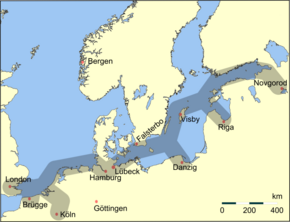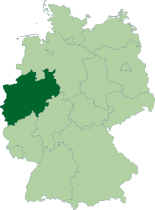Bochum
| Bochum | |
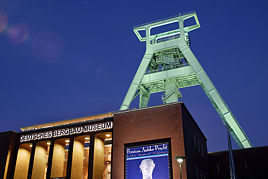 |
|
| Coat of arms | Location |
 |
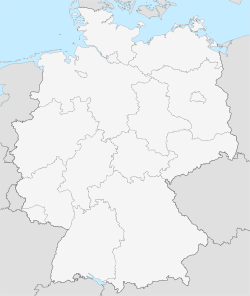 |
| Administration | |
| Country | Germany |
|---|---|
| State | North Rhine-Westphalia |
| Admin. region | Arnsberg |
| District | Urban district |
| Mayor | Ottilie Scholz (SPD) |
| Basic statistics | |
| Area | 145.4 km² (56.1 sq mi) |
| Population | 376,586 (30/10/2006) |
| - Density | 2,590 /km² (6,708 /sq mi) |
| Other information | |
| Time zone | CET/CEST (UTC+1/+2) |
| Licence plate | BO |
| Postal codes | 44701-44894 |
| Area codes | 0234, 02327 |
| Website | www.bochum.de |
Bochum (IPA: [ˈboːχʊm]) is a city in North Rhine-Westphalia, western Germany. It is located in the Ruhr area and surrounded by the cities of Essen, Gelsenkirchen, Herne, Recklinghausen, Dortmund, Witten and Hattingen.
Contents |
History
The foundations of Bochum were started in the 9th century when Charlemagne set up a royal court at the junction of two important trade routes and it was first officially mentioned in 1041 by the name Cofbuokheim in a document of the archbishops of Cologne. Originally it may have meant "Brookhome" or "Bacheim" later it seems to have gained the notorious reputation of "Bookhorn" or "Horn" "Book". In 1321 Count Engelbert II von der Marck granted Bochum a town charter, but the town remained insignificant until the 19th century, when coal mining and steel industry emerged in the Ruhr area, leading to the growth of the entire region. The population of Bochum increased tenfold between 1850 and 1890 while part of the Prussian Province of Westphalia.
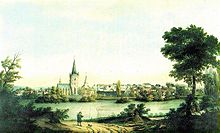

In World War II the city was heavily bombed by British and American bombers. Nearly the whole inner circle of the city was destroyed and many thousands of citizens were killed. Bochum became part of the new state of North Rhine-Westphalia after the war.
Between 1960 and 1980, all the mines were closed. Other industries, such as car making, compensated for the loss of jobs. The Opel Astra is assembled by General Motors at their plant here. In 1965 the Ruhr University was opened, the first university in the Ruhr area and the first to be founded in Germany since World War II.
In the course of a comprehensive community reform in 1975, Wattenscheid, a formerly independent city, was integrated into the urban area of Bochum. An exerted local referendum against the integration failed. In 2008 Nokia planned on closing down its production plant. The plans met heavy opposition and 20,000 people showed up for the protests.
Main sights



Main sights include:
- The Town Hall
- Propsteikirche St. Peter und Paul, the most ancient church of the city, built in 785-800 by Charlemagne. It was rebuilt in the 11th century but had to be reconstructed starting from 1547, after a fire in 1517, in late-Gothic style. The 68 m-high bell tower is one of the landmarks of Bochum. the interior include an 1175 baptismal font, the relic shrine of St. Perpetua and her slave Felicitas, and a hig altar with a 1352 Crucifix.
- Pauluskirche, the main Protestant church of the city. It was built in the 1650 with donations from Northern Europe.
- Christuskirche.
- the neo-Gothic Marienkirche (1868-1872).
- Church of St. Vincent (c. 1000). Originally an example of Ottonian architecture, it was rebuilt in Romanesque style, and later turned into a Gothic edifice. In 1905 a neo-Gothic section was added. It houses a precious Baroque altar (1699) and a 16th century organ.
- Blankenstein Castle, built in the 13th century by Count Adolf I of Mark. Today the gate and a tower remain.
- Zeiss Planetary
Two castles from the Middle Ages survive on the northern banks of the Ruhr river. Other points of interest include the German Mining Museum, the musical Starlight Express (opening show in 1988) and the nostalgic Train Museum in the borough of Dahlhausen.
Bochum has its own brewery, Moritz Fiege which produces pilsner, a low alcohol pilsner & hell style beers.
Sport
The football club VfL Bochum was 8th of the First Division (1. Bundesliga) in the season of 2007/08.
Transport
Bochum is connected to the Autobahn network by the A 40, A 43 and A 44 autobahns. It has a central station situated on the line from Duisburg to Dortmund, connecting the city to the long-distance network of Deutsche Bahn as well as to the S-Bahn network of Rhine-Ruhr. Local service is carried out by the BOGESTRA, a joint venture between the cities of Bochum and Gelsenkirchen. There is a single underground Stadtbahn line connecting the University of Bochum to Herne, and several tram lines connecting to Gelsenkirchen and Witten. Public transport in the city is carried out according to the fare system of the VRR transport association.
Educational institutions
Secondary educational institutions
- Ruhr University founded 1965
- Hochschule Bochum - Bochum University of Applied Sciences (former Fachhochschule Bochum)
- TFH Georg Agricola
- Evangelische FH Rheinland-Westfalen-Lippe
- Schauspielschule Bochum
- Fachhochschule des Bundes der Sozialversicherung, Abteilung Knappschaft-Bahn-See
Schools
There are 61 primary schools, 9 Hauptschule("general schools") and 14 special schools.
11 grammar schools ("Gymnasium"):
- Albert-Einstein-Schule
- Goethe-Schule Bochum
- Graf-Engelbert-Schule
- Gymnasium am Ostring
- Heinrich-von-Kleist-Schule
- Hellweg-Schule
- Hildegardis-Schule
- Lessing-Schule
- Märkische Schule
- Schiller-Schule
- Theodor-Körner-Schule
5 comprehensive schools ("Gesamtschule"):
- Erich Kästner-Gesamtschule Schule
- Heinrich-Böll-Gesamtschule
- Maria Sibylla Merian-Gesamtschule
- Willy-Brandt-Gesamtschule
- Matthias-Claudius-Schulen
8 Realschule:
- Anne-Frank-Schule
- Annette-von-Droste-Hülshoff-Schule
- Franz-Dinnendahl-Schule
- Hans-Böckler-Schule
- Helene-Lange-Schule
- Hugo-Schultz-Schule
- Pestalozzi-Schule
- Realschule Höntrop
- Freie-Schule Bochum (with primary grade)
Furthermore, there are two Waldorf schools(private schools):
- Rudolf Steiner Schule Bochum
- Widar Schule Wattenscheid
Twin towns
Bochum's twin towns are:
 Sheffield, United Kingdom, since 1950
Sheffield, United Kingdom, since 1950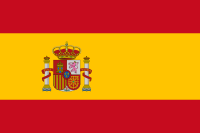 Oviedo, Spain, since 1980
Oviedo, Spain, since 1980 Donetsk, Ukraine, since 1987
Donetsk, Ukraine, since 1987 Nordhausen, Germany, since 1990
Nordhausen, Germany, since 1990 Xuzhou, People's Republic of China, since 1994
Xuzhou, People's Republic of China, since 1994
People affiliated with Bochum
- Alfred Keller, a Luftwaffe general during the Second World War
- Andrei Osterman, Russian Statesman
- Wolfgang Clement, former minister of economics and work
- Norbert Lammert, President (Speaker) of the German Parliament, Bundestag
- Herbert Grönemeyer, singer, wrote a popular song about Bochum in 1984.
- Frank Goosen, writer, wrote an epic story taking place in Bochum in the 1980s and 90's (liegen lernen)
- Otto Schily, former minister of the interior
- Mark Warnecke, breaststroke swimmer, won the world title at age 35
- André Tanneberger also known as ATB, electronic music producer
See also
- Bochum-Hamme
- Starlight Express
- Bermudadreieck
- International Cycling Video Festival
External links
|
||||||||||||||||||||||||||
|
||||||||||

